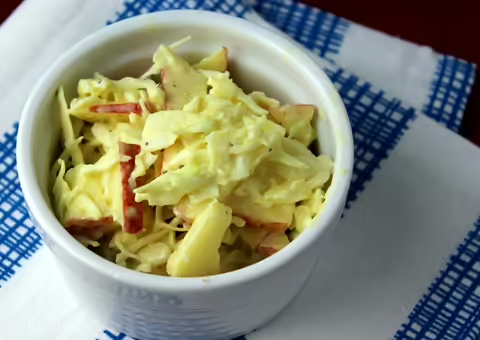
Visualize the experience of eating an apple. Hear the crunch. Feel the juice dripping on your chin. Taste the sweet and tart flavors. Ah, it feels like fall!
Nutritionally, 1 medium apple (around 3-inches across) contains around 95 calories, 25g carbohydrate, 4g fiber, and is a source of vitamins and minerals, including vitamin C, folate, and potassium. Like other fruits, apples are not a significant source of fat, protein, or sodium.
- Buy: Choose apples that are firm without obvious bruises or punctured areas. When buying apples, think about how you want to use them. For example, if you want a sweet apple, avoid Granny Smiths, which are more tart.
- Price: Fresh apples average $1.62 per pound (or about $0.44 per cup), according to the U.S. Department of Agriculture. Applesauce averages $1.05 per pound (or $0.57 per cup), and apple juice averages $0.63 per 16-ounces.
- Store: Place unwashed apples in the refrigerator for several weeks. With longer storage and low humidity, apples can lose moisture and start to wrinkle and become soft. Shelf-stable applesauce and apple juice can be stored at room temperature until opened. Once opened, refrigerate and use within 1-2 weeks.
- Prepare: Wash fresh apples under cool water before eating or using in recipes. Skins are edible, but peel if desired.
- Preserve: Apples hold up well to a variety of food preservation methods. Check out instructions from the National Center for Home Food Preservation on freezing, drying, and canning apples. Also check out our "Fill Your Pantry" recorded webinar on Preserving Apples at Home.
- Eat: There are so many varieties of apples with different colors and flavor. I encourage you to try a new variety this fall. Along with simply snacking on an apple, try your hand adding apples to recipes, including these three fall-inspired side dishes.
Squash, Apple, and Cranberry Casserole | Print recipe | Watch video
Serves 6
3 cups cubed winter squash (such as butternut or acorn)
2 cups cubed baking apples* (such as Granny Smith)
1/2 tsp nutmeg
1 tsp cinnamon
1 Tbsp brown sugar
1/4 cup dried cranberries
- Preheat oven to 350°F.
- Wash hands with soap and water.
- Gently rub produce under cool running water.
- Combine cubed squash and apples in an 8x8 inch pan.
- Sprinkle nutmeg, cinnamon and brown sugar over squash and apple mixture.
- Top mixture with dried cranberries.
- Cover pan with aluminum foil and bake for 45-60 minutes, or until squash and apples are tender.
*Other baking apples you could use include McIntosh, Jonagold, or Braeburn
Nutritional analysis per serving: 80 calories, 0g fat, 0mg sodium, 19g carbohydrate, 3g fiber, 1g protein
Source: Eat.Move.Save., Illinois Nutrition Education Programs, University of Illinois Extension.
Modified from "Squash Apple Casserole" found at www.usda.gov/whatscooking
Roasted Fall Medley | Print recipe
Serves 4
1 medium apple
1 large sweet potato
1 large carrot
½ tsp cinnamon
1 Tbsp oil
- Preheat oven to 375°F. Line a baking sheet with foil or parchment paper.
- Wash hands with soap and water.
- Wash and peel apple, sweet potato, and carrot. Cut into 1-inch cubes. Add to a bowl with cinnamon and oil. Toss to coat. Spread evenly on baking sheet.
- Bake for 30-45 minutes, or until medley is tender. No need to stir medley. Remove baking sheet from oven. Let mixture sit for 5 minutes for easier removal of medley.
Nutritional analysis per serving: 90 calories, 4g fat, 30mg sodium, 14g carbohydrate, 2g fiber, 1g protein
Apple Cabbage Slaw | Print recipe
Serves 4
1 cup apple, thinly sliced
2 cups shredded cabbage
1/4 cup plain nonfat yogurt
1/4 tsp mustard
1 Tbsp vinegar
1/8 tsp salt
1/8 tsp black pepper
- Wash hands with soap and water.
- Wash apple and cabbage under cool running water.
- Lightly mix sliced apples and shredded cabbage together in a medium bowl.
- Add yogurt, vinegar, mustard, salt, and pepper to apples and cabbage. Stir gently
- Serve immediately or refrigerate.
Nutritional analysis per serving: 35 calories, 0g fat, 95mg sodium, 7g carbohydrate, 2g fiber, 2g protein
Source: Eat.Move.Save., Illinois Nutrition Education Programs, University of Illinois Extension.
Resources
- North Dakota State University, From Orchards to Tables: Apples, 2017
- Virginia Cooperative Extension, Eat Smart, Move More at Farmers Markets: Apples, N/D
Healthy Eats and Repeat
How much difference is there between canned and frozen foods? How should you cook venison? When is the best time to buy avocados? Get answers to these questions as well as other tips, tutorials and recipes for common kitchen foods and items with University of Illinois Extension Nutrition & Wellness Educator Caitlin Mellendorf’s blog Healthy Eats and Repeat. Build your best life. Trust Extension to help.
Caitlin Mellendorf is an Illinois Extension Nutrition and Wellness Educator serving DeWitt, Macon and Piatt Counties in Central Illinois. She is a Registered Dietitian and her work focuses on helping community members gain the knowledge, skills and tools to live healthier, more nutritious lifestyles. This includes providing programs and answering questions about heart health, diabetes, food safety, food preservation, grocery shopping and cooking. You can reach Caitlin by email at chuth2@illinois.edu or call 217.877.6042. Check out her nutrition blog Healthy Eats and Repeats for seasonal recipes and of an exploration of common kitchen foods.


